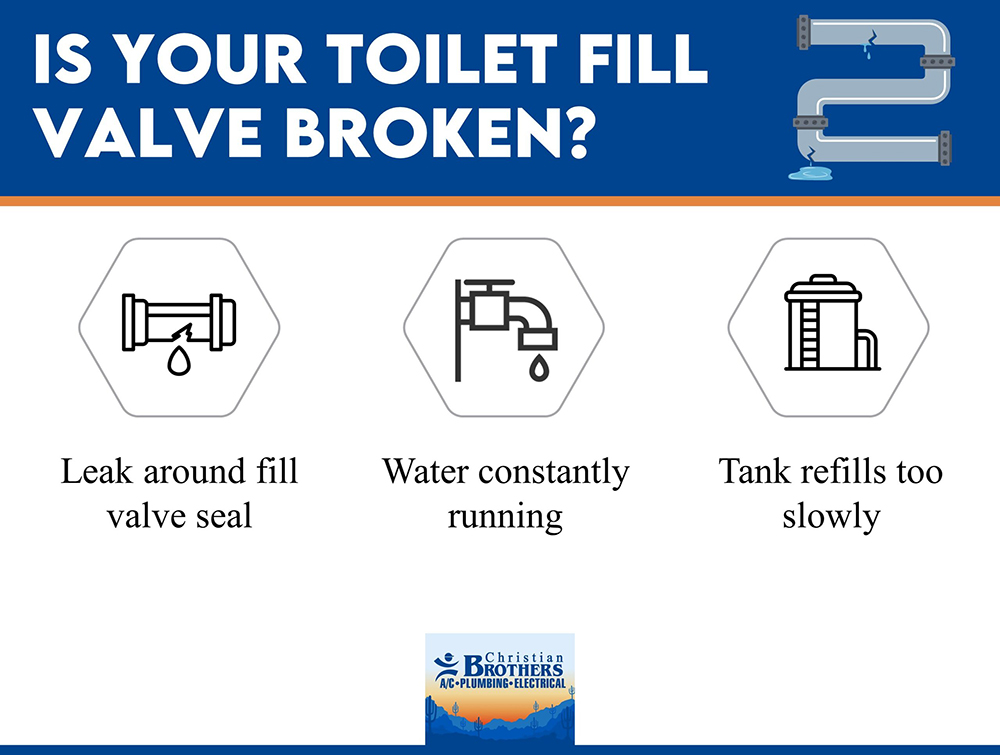Updated: April 10, 2024
For many Glendale homeowners, the inside of a toilet tank is a mystery to them. This part of the toilet is filled with all sorts of devices that move around and gurgle out water, so it’s normal to be a bit confused if you don’t do much DIY. However, it pays to familiarize yourself with the parts of a toilet. Understanding what each part is and how it works can help you troubleshoot common problems and make your toilet more efficient.
The toilet fill valve is one of the most important parts of a toilet. What is a toilet fill valve? The expert plumbers at Christian Brothers Air Conditioning Plumbing Electrical explain where to find it and how to recognize something is wrong. Read on to learn more!
How to Locate Your Toilet Fill Valve
Different fill valves can look different, depending on their designs. Some can have a few pipes running around them, and others might have a floating, ball-shaped item. The majority of fill valves are black and gray, but some might have a little red, white, or blue on them. Modern fill valves are almost always plastic, but some older ones are made out of metal.

What Does a Toilet Fill Valve Do?
The toilet fill valve has a very important role in keeping your toilet running. Its main goal is to control the amount of freshwater that enters your toilet tank. This is why the fill valve is so tall. It connects to a supply pipe at the bottom of the tank, and then it stretches up to the water line at the top of the tank.
Fill valves have a helpful design that automatically manages water flow. The valve is designed to open the supply pipe when water is below a certain level so that when you flush your toilet, the tank empties, and then the valve mechanism will let water flow into the tank. Once your water reaches a certain level, the valve automatically turns off, stopping the water. This helps to ensure that you have enough water to quickly flush your toilet.
What Are the Types of Toilet Fill Valves?
Toilet fill valves have a very simple, reliable design, so there have been few changes over the years. Though most valves look incredibly similar, there are a few distinct differences to be aware of. Any time you are working on your toilet, you need to make sure you are following instructions for the right style of valve.
The oldest style of toilet fill valve is a ballcock style. This valve has a long arm with a round, air-filled ball on the end. The ball floats on top of the water, so it can tip your valve into the off position once it reaches a certain height. Most toilets have switched to a float-cup valve in modern times. Instead of a long arm with a ball, this valve has a cylindrical cup that wraps around the main stem. It floats up and down to open or close the valve. Though rare, some toilets might have other designs, like a float-less fill valve or a diaphragm fill valve.
Ways to Tell If Your Toilet Fill Valve Is Broken
If your toilet fill valve isn’t working, the normal flow of water to your tank will be disrupted. There are many different ways that this can happen, so you will need to be on the lookout for a variety of issues. For example, you could get a leak around your fill valve seal, the mineral buildup could block your fill valve, or the connection between the fill valve and toilet flapper could get broken.
The most common sign of a broken fill valve is water constantly running. You may be able to hear a humming noise or see water pouring into your toilet bowl all the time. However, it is possible for a valve to just develop a tiny leak that barely allows water to trickle through. To test for this, wait until your bowl is filled up, and then add a few drops of food coloring to the tank. If the water in the bowl changes color, your valve could be broken.
In other cases, a broken fill valve can stop water from running into the tank properly. You might notice that your tank is taking ages to refill. If you are getting too little water in your tank, your toilet might not flush, or it might have a very weak flush.
Should You Replace or Repair a Broken Fill Valve?
If your fill valve isn’t working correctly, you have several options. Many common issues are easily fixable. You might just need to flush the fill valve to remove sediment buildup or to adjust the fittings to prevent a leak. A fill valve is made of several separate parts, so you can often fix it just by replacing one faulty seal.
However, in some cases, your fill valve may be too broken to repair. Fortunately, it is fairly cheap and easy to replace a fill valve, the process just involves mounting the device inside the toilet and connecting a few pipes. Some experienced DIYers do this themselves, but other homeowners prefer professional help.
How to Adjust a Toilet Fill Valve
Even if your fill valve is working just fine, you might want to take a little time to tinker with it. Your fill valve settings control how much water your tank has, so they can be quite important. If you fill your tank too much, you could be wasting water with each flush. However, if you set your tank too low, you’ll end up with a weak flush that might not move everything down the drain.
The right adjustment method depends on your fill valve style. If you have an older ballcock style, you will need to bend the metal rod. Bending it upwards will increase the water in your tank while bending it downwards will decrease your tank water level. If you have a float cup valve, look for a small arm that extends from the top and that attaches to a stick on the little float. Some float cups have a screw you can turn, and others use a metal clip. The main thing is just to adjust the position of the float and the rod. The float should be farther down on the rod if you want a low water level, and it should be attached higher up to create a higher water level.
Contact Our Plumbers Today
If you have any other questions about your plumbing, or need help with toilet repair, Christian Brothers Air Conditioning Plumbing Electrical is here to assist you. Our plumbers can help you with a variety of repairs and installations. We also offer a broad range of other plumbing services in the Glendale and Phoenix Metro Areas. You can also count on us for reliable and quality electric, heating, and cooling services. Give us a call today to learn more.









